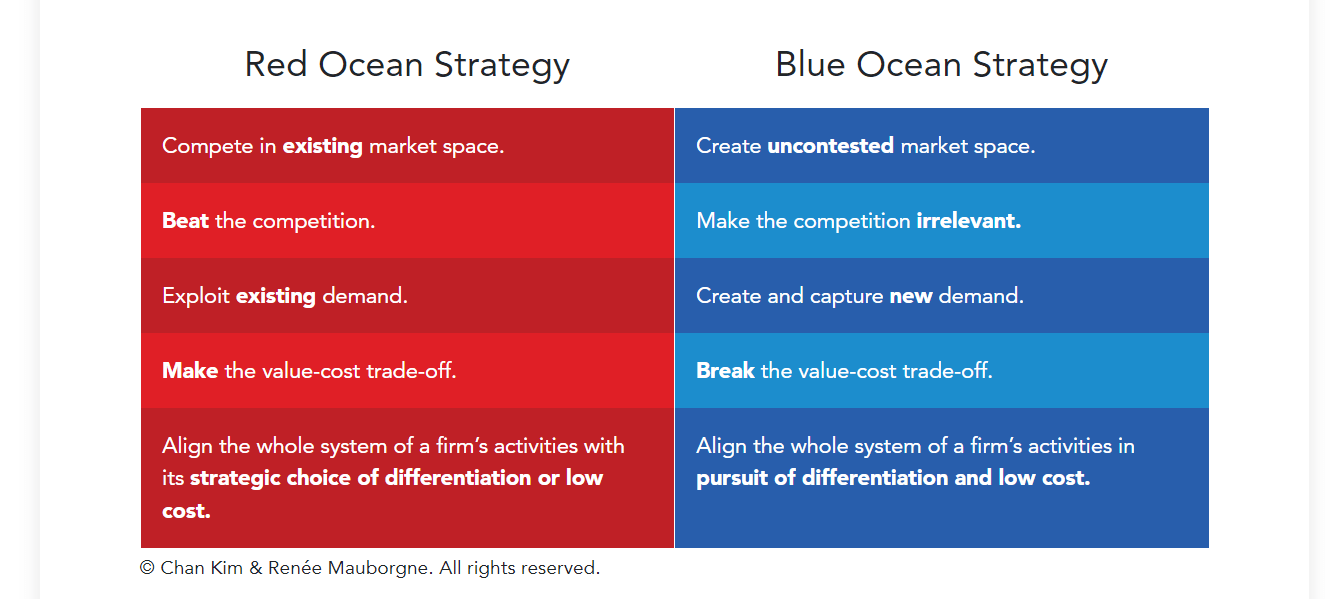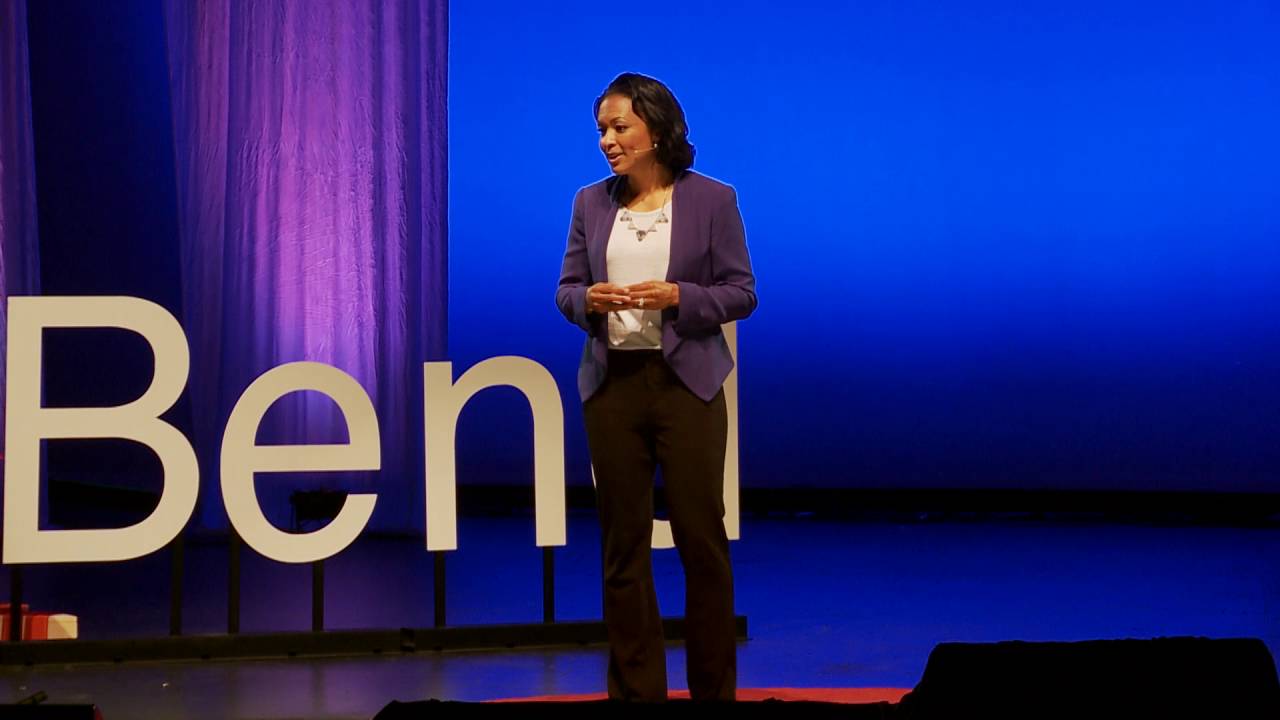4 leadership qualities all good leaders have in common
What is a good leader? What are the leadership qualities that make a good leader? Let’s find out!
Leadership Quality #1: Communication, empathy and emotional support
Empathy is walking in somebody else’s shoes and seeing the world through their eyes.
Do we need empathetic leaders?
Absolutely!
Because an empathetic leader makes the other person feel seen.
And what an amazing feeling it is to feel that the other person understands not what you’re going through but how you are feeling because feelings are universal.
An empathetic leader nurtures stronger relationships based on mutual respect and trust. When the leader trusts you, you feel empowered to live up to that level of trust and do your best work.
As Microsoft CEO Satya Nadella said recently in his interview with Ryan Roslanki, CEO of LinkedIn, don’t wait for the next job to do your best work.
Learn more: 6 phrases every good team leader should say to their team members
Leadership Quality #2: Active listening
In this day and age, with all the distractions around us, it’s incredibly easy to zone out and drift away into a world of our own.
It’s certainly a place and time for this because it allows the mind to relax and recharge and leaders must know how to carve out ‘me time’ every day.
When they are with their team, leaders should practise being in the present moment and connected to whoever they are talking to.
No phones, no notifications, no calls, no interruptions. Active listening means first and foremost listening with the intent to understand what the other person is saying and how they are feeling. Ask open-ended and follow-up questions and summarize to make sure you understand correctly.
Leadership Quality #3: Mentoring
Latest reports highlight the importance of mentorship in the workplace.
Professionals in every generation, and especially Gen Z, expect their employers to provide them with opportunities to learn and grow.
The job is not just a means to pay the bills, it’s a way to develop and acquire skills and become the best that we can be.
The workplace is where we feel safe to bring our whole selves, pursue goals that are important to us and grow in the direction that we want.
That’s where mentorship comes in. Be the mentor your team members need. Share your lessons with them and offer them guidance to reach their goals.
Leadership Quality #4: The ability to unite the team around your vision
Every leader has a vision of the future.
Bill Gates envisioned a world where there is a computer in every home. Elon Musk envisions a future where humankind expands to Mars and other planets.
A leader may start alone but needs a close-knit team to bring the vision to life. And that takes time and effort.
First, you need to be able to articulate your vision in a way that every member of your team can understand which is highly challenging.
What do you tell them? What do you show them? How do you make them understand? How do you make them believe in your vision as strongly as you do?
It’s hard work because people have different views of the world today and based on their previous experiences they will imagine a different world of tomorrow.
The answer lies in continuous communication with your team and when possible, showing examples.
Talk to them about what your vision is and is not, invite questions, encourage conversations and allow them to be wrong so they can learn from it.
BRAND MINDS: 30 top reasons to bring your team
BRAND MINDS is among the Top 5 largest business conferences in Europe providing its attendees with a unique business edutainment experience.

More than 6000 professionals from 500 companies in 80 countries attended BRAND MINDS on June 2nd and 3rd, 2023.
Bring your team to BRAND MINDS because teams who learn together will grow the company together.
30 reasons to bring your team to BRAND MINDS
You and your team will:
#1 Learn business strategy from the most respected business experts in the world;
#2 Access the opportunity to interact with +7000 business specialists from over 50 countries;
#3 Reconnect with business partners from +11 industries;
#4 Learn how to create an organizational culture where people develop exponentially;
#5 Discover the latest trends in design thinking & innovation;
#6 Discover new models of leadership & team management;
#7 Discover the latest trends in professional development;
#8 Enjoy the most memorable teambuilding yet;
#9 Connect with the latest trends in technology & artificial intelligence;
#10 Learn tactics to overcome any sales objection;
#11 Learn to build an effective digital marketing strategy for your company.
#12 Learn new techniques to develop healthy habits that will help you achieve your vision;
#13 Learn techniques to amplify autonomy & innovation in your team;
#14 Enjoy a complex learning experience, equal to reading 8 books in a day;
#15 Leave with at least 3 actionable ideas to scale up your company;
#16 Discover 8 habits that amplify creativity in a team;
#17 Learn the most effective risk management strategies;
#18 Learn to develop a high-performing sales team;
#19 Learn the latest tactics in sales strategy to close big clients;
#20 Access the opportunity to build new business partnerships;
#21 Network with decision-makers from +300 Top companies;
#22 Discover global economic trends that will help you adapt your business strategy for the future;
#23 Learn team engagement techniques through design thinking;
#24 Learn how to achieve the most ambitious career goals without facing burnout;
#25 Discover artificial intelligence tools that will help your company adapt for the future;
#26 Learn the most common mistakes leaders make that result in team demotivation;
#27 Learn the latest strategies and frameworks of customer loyalization through digital marketing;
#28 Leave with the BRAND MINDS World-Changer participation certificate;
#29 Meet authors among the most respected internationally in a live, in-person event;
#30 Access the opportunity to interact with some of the most renowned business experts of the moment.
Top 10 essential leadership skills for managers for 2023
The top 10 in-demand job skills for 2025 list reported by World Economic Forum (WEF) is outdated.
There are new job skills employers are looking for and we present them in this article.
The world is changing at a breakneck pace. New technologies are disrupting industries, different generations with different values are working together in the same office and people are using new ways to communicate and express themselves.
The workplace is not the same as it was two years ago, let alone five or ten. Leadership and people management are today at a crossroads (see our piece on quiet quitting) and the skills employers are looking for in new hires are changing almost every year.
That’s why we believe the list of top 10 in-demand job skills for 2025 that the World Economic Forum published two years ago needs updating.
The Top 10 in-demand job Skills for 2025 Before the Great Resignation
Every year, the World Economic Forum publishes the Future of Jobs report which showcases various highly useful statistics and data including the top skills required for jobs five years in the future.
Here are the WEF’s recommendations for 2025:
- Analytical thinking and innovation
- Active learning and learning strategies
- Complex problem solving
- Critical thinking and analysis
- Creativity, originality and initiative
- Leadership and social influence
- Technology use, monitoring and control
- Technology design and programming
- Resilience, stress tolerance and flexibility
- Reasoning, problem-solving and ideation
The problem with the latest report of the forum is that it was published before the Great Resignation and its impact on the global workforce, which began in early 2021. It’s 2022 and the business environment is struggling with a new trend: Quiet Quitting.
Both the Great Resignation and Quiet Quitting are symptoms of the same problem: lack of good leadership.
It’s not that before the pandemic employees didn’t have leadership. They had. But in today’s world, a world of work-from-home, work-from-everywhere, with a healthier work-life balance, a new type of leadership is required.
The type of leadership Future of Work Strategy Expert @London Business School and BRAND MINDS 2023 speaker Lynda Gratton writes about in her article for Harvard Business Review, Managers can’t do it all.
The Top 10 essential leadership skills for 2023 after the Great Resignation + Quiet Quitting, for Managers
What are employees looking for in their job roles?
Values alignment. Millennials and Generation Z are now the largest segments in the workplace. What countless surveys and reports have found was that the members of both generations are seeking jobs in mission-driven companies whose values align with their own. When companies fail to live up to their own values and the employees’ expectations, the employees will take it to the street with protests and call-outs. And I give just two examples: the Google walkouts in 2018, and more recently, the pressure employees and customers have put on brands still doing business in Russia.
Flexible work schedules. Millennials with families expect their jobs to provide them with a healthy work-life balance where they can spend quality time with their children and spouses. Nearly 1 in 5 Gen Z’ers want to run their own business, and the vast majority of them have one pet hobby they would like to nurture and manage so flexible work schedules are important for them too.
Professional Growth & Development Opportunities. No one wants to do the same job for years and then retire. Employees want to grow as professionals and advance in their careers. They expect employers to provide them with on-site training or offer a training allowance they can use to develop their skills further. According to LinkedIn statistics, Gen Z learners watched 50% more hours of educational content on LinkedIn. Improve my skills to improve your company.
Opinion heard and Initiative welcomed. There is no bigger satisfaction than working in an environment where your opinion is heard, your input is valued and you are expected and encouraged to improve how the company is doing email marketing, or customer service or product design. When you see how your work contributes to the organization’s larger purpose, it’s the best feeling.
What skills are managers expected to acquire or develop?
Performance development. Managers need to shift from performance management to performance development. It’s not enough to monitor and assess performance, they need to support employees in developing their skills which leads to increased performance.
Communication, Empathy and emotional support. Gallup recommends that managers have one meaningful conversation per week with each team member — 15-30 minutes. They found this helps employees reduce disengagement and burnout.
S-curve employee learning management. The S learning curve strategy is a great framework to build a winning team and a highly efficient tool for employee development. This framework is the essence of professional development for employees at every stage of their careers. The manager identifies any skills gap the employee needs to close.
Diversity and inclusion management. Generation Z is the most diverse generation we have ever seen. Managing and nurturing the development of these workers needs to align with the company’s business goals and the development needs of other generations working together in the same office.
Top 10 essential leadership skills for managers for 2023, BRAND MINDS edition
- Performance development
- Peer-to-peer and team coaching
- S-learning curve management
- Communication, Empathy and emotional support
- Employee growth culture
- Engagement and retaining
- Retraining and career coaching
- Diversity and inclusion support
- Skills gap anticipation
- Agility

6 leadership lessons from New Amsterdam, the popular TV medical drama
New Amsterdam is the latest TV medical drama watched by viewers worldwide.
The series follows Dr Max Goodwin as he becomes the medical director of New Amsterdam Hospital, one of the United States’ oldest public hospitals. His responsibility is to make changes that would improve the hospital’s financial situation while providing high-quality medical services for patients.
Max’s decisions are great examples of good leadership.

Max Goodwin / nbc.com
6 leadership lessons from the popular TV medical drama New Amsterdam
1. Serve your people
If I were to sum up Max Goodwin in four words they would be How can I help?
This is the question that Max asks every doctor in his team. He doesn’t tell people what to do, he doesn’t boss them around. Instead, he invites them to tell him what they need to do their jobs better.
How can I help? is one of the most powerful questions a leader could ask. And one of the most uncomfortable too.
It is powerful because it shows so much in so few words.
When a leader asks an employee How can I help?, he opens a communication channel. Instead of a speech delivered to the whole team at the same time, the leader chooses to talk to one person at a time. It’s a conversation, not a speech; it’s one-to-one, not one-to-many.
The leader offers his undivided attention to the employee and trusts them to tell him what they need to do their jobs better hence get better results for the company.
It is also an uncomfortable question because it puts the leader in a situation that many might find uneasy.
Some leaders believe they provide employees with everything they need to deliver the best results. Others believe they know better than their employees or that the company is running so well there’s no need for improvement.
Max Goodwin is the servant leader type.
Servant leaders tell their employees My job is to meet your needs. In a company led by a servant leader, team members feel heard and supported in their work which leads to high worker satisfaction rates.
The servant leader strives to help people grow, has good listening skills and a high level of empathy and emotional intelligence.
Of course, it’s not enough to listen and nod in approval, the leader must also deliver on his promise.
2. Implement radical decisions, challenge the status quo
At the first all-hands meeting since his appointment as the medical director of New Amsterdam Hospital, Max’s first decision is to fire the entire cardiac surgical department.
The department had the highest infections and death rate in New York City and the doctors were corrupt and greedy placing their earnings above their patients’ interests.
A decision deemed outrageous by the rest of the city’s medical directors. This is Max’s first in a series of controversial yet beneficial decisions to both the hospital and the patients.
When something needs to change, change it.
Be fearless and make the necessary decisions to improve your company or your team’s productivity.
Change the guidelines, change the requirements, change the company’s values if they don’t reflect your vision any longer.
Provide your team with the opportunity to support the change.
3. It’s ok to go back on your decisions
After Max fired every cardiac surgeon at New Amsterdam Hospital, he went back on his decision regarding dr Reynolds.
Dr Reynolds was a cardiac surgeon who stood out among his department colleagues as the only surgeon who had always put his patients’ well-being above his surgeon paycheck.
Max hires dr Reynolds back, promotes him to Head of Cardiovascular Surgery and assures him of his full support in putting a team of the best and diverse cardiac surgeons.
No one sets out to make bad decisions.
We make decisions based on the information we had at the time. If later those decisions prove to be wrong, it’s no use feeling bad about it. It’s the best we could have done at the time being.
Tell your team about your decision and the reasons behind it, why it was a good decision at the time and why it isn’t good anymore now.
Be open and honest, your team will appreciate and respect you for it.
4. Find a partner to keep you in check and brainstorm ideas with
Some studies on startups have reported that startups with two or more co-founders are more successful while others argued that startups with a single founder do better. This article writes about the pros and cons of married co-founders.
On one hand, if your startup is looking to raise money, statistics showed that companies with two or more founders were able to attract more money than those led by a single founder.
On the other hand, companies with a single founder were more likely to still be in business than those with two or more.
Whichever option you go with, whether you are leading a company or just a team, it’s always better to have someone to run your ideas by and keep you grounded.
A different viewpoint on a certain situation could provide additional insight and a potential solution.
Dr Helen Sharpe is Max’s partner. She is the Head of Oncology and Hematology and the Deputy Medical Director of New Amsterdam Hospital.
Helen is practical and realistic. She understands what Max is trying to achieve and is totally supportive although sometimes she sees things differently and pushes against his decisions.
5. Find creative solutions to difficult problems
There are many reasons viewers enjoy watching New Amsterdam. One of them is seeing Max find creative solutions to difficult problems which would be easily solved by firing employees or accepting the status quo.
Like the time he tried to find a solution for hospital employees doing obsolete jobs.
Instead of firing them, he decides to open a new hospital in a city where medical services were needed. These employees had a new hospital they could work in and feel useful.
Or the time he tried to help save the hospital money by finding a solution for a homeless patient, whose frequent hospital visits had cost New Amsterdam over a million dollars in one year. He realizes the patient knew the hospital inside out so instead of sending him to live on the street again, he gives him a job in the hospital.
6. Always do what’s best for your stakeholders
The Shareholder Theory states that a company’s main responsibility is to its shareholders i.e. owners of shares in the respective company. Milton Friedman, Nobel Prize recipient, economist and the author of the Shareholder Theory which he published in 1970 argued that the business goal of any company is to maximize returns to its shareholders.
This theory had a great influence on the business world and laid the foundation for corporate America. Big for-profit corporations had negative consequences on the American economic system and society at large.
Things have changed. Today, 181 CEOs of billion-dollar companies say it’s time to put the Shareholder Theory where it belongs – in the past and focus their efforts towards stakeholders.
For New Amsterdam, the stakeholders are the patients.
Max Goodwin’s decisions are always focused on providing exceptional care to patients by fighting bureaucracy and overturning the status quo.
For companies, stakeholders are their customers, employees, suppliers and the communities they do business in.
Corporations like Apple, Amazon and Coca-Cola have committed to deliver value to customers, invest in employees, deal fairly and ethically with suppliers and support the communities in which they work.
Join the Conversation
We’d love to hear what you have to say.
Get in touch with us on our LinkedIn Page, Facebook Page, Twitter or TikTok.
Blue Ocean Strategy: How to differentiate from the competition
On this page:
- Definition of Blue Ocean Strategy – What is Blue Ocean Strategy? Who created Blue Ocean Strategy?
- Differences between Red Ocean Strategy and Blue Ocean Strategy in business and leadership
- 3 brands that have differentiated from the competition, generated new demand and found a new market
- How to create a blue ocean for your company through value innovation
What is Blue Ocean Strategy?
Every entrepreneur wishes their company was the only one in the market. No competitors, having all the customers to themselves. King of the castle ruling unchallenged over the country.
While for most entrepreneurs this dream is only wishful thinking, for some it’s reality.
These entrepreneurs (and we will talk about three of them later) have led their companies to great success by applying Blue Ocean Strategy.
Blue ocean strategy is the simultaneous pursuit of differentiation and low cost to open up a new market space and create new demand. It is about creating and capturing uncontested market space, thereby making the competition irrelevant. It is based on the view that market boundaries and industry structure are not a given and can be reconstructed by the actions and beliefs of industry players.
Who created the Blue Ocean Strategy?
Blue Ocean Strategy was created by management thinkers Chan Kim and Renée Mauborgne.
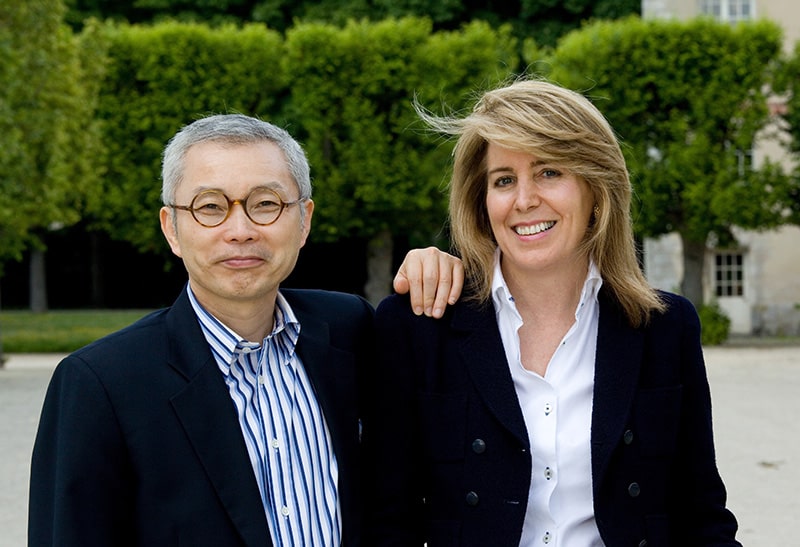
Chan Kim and Renée Mauborgne (image source: blueoceanstrategy.com)
Both Chan and Renée are Professors of Strategy at INSEAD, one of the world’s top business schools, and co-directors of the INSEAD Blue Ocean Strategy Institute in France.
In 2005, Chan Kim and Renée Mauborgne co-authored Blue Ocean Strategy. The book shows the results of a study of 150 strategic moves spanning more than 100 years across 30 industries. The authors’ conclusion is that lasting success comes not from battling competitors but from creating blue oceans – untapped new market spaces ripe for growth.
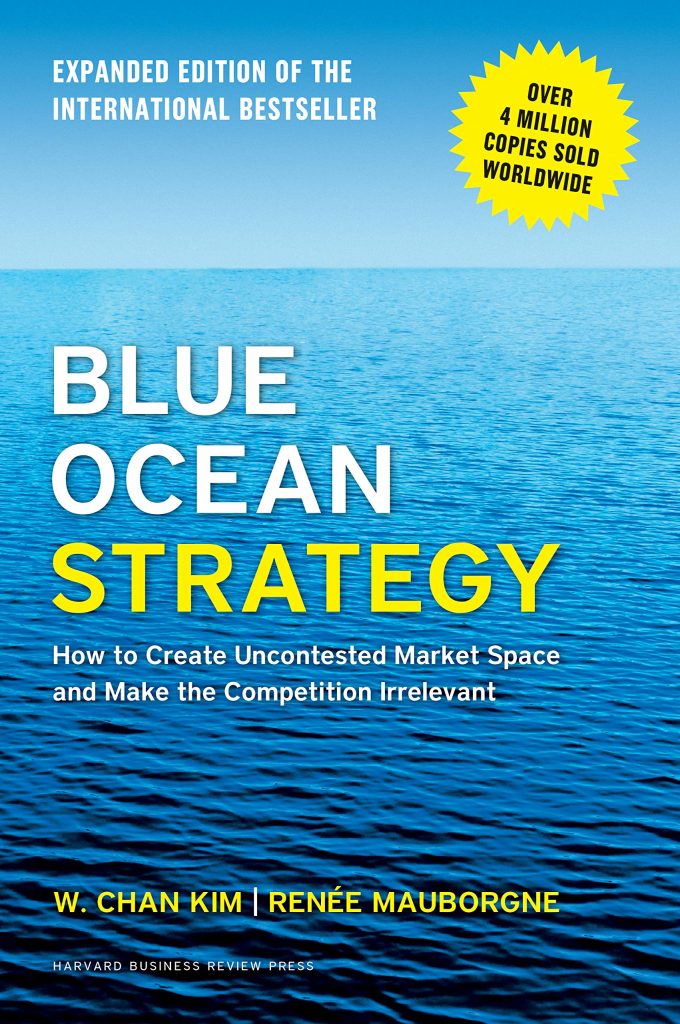
Since its first edition, Blue Ocean Strategy has been revised and expanded in 2015 and has become a bestseller with over 4 million copies sold in 46 languages.
The book is recognized as one of the most iconic and impactful strategy books ever written and is the recipient of numerous distinguished awards. Both authors received widespread recognition for their work in the form of various awards and distinctions.
Apart from their careers in academia, Chan and Renée have been employed in an advisory capacity by prestigious organizations. Kim is an advisory member for the European Union and serves as an advisor to several countries and Renée served on President Barack Obama’s Board of Advisors on Historically Black Colleges and Universities (HBCUs) for the president’s two terms.
In 2019, Thinkers50 named Chan Kim and Renée Mauborgne the #1 Business Thinkers in the World.

How to grow your business with 1 strategy framework
Differences between Red Ocean Strategy and Blue Ocean in business and leadership
In Blue Ocean Strategy, red ocean is a metaphor for the known market space encompassing all the industries in existence today. Remember the documentaries that showed the audience what happens when a large number of sharks feed at the same time, in the same place? It’s called a shark feeding frenzy event and it turns the ocean water red with the blood of the fish the sharks are feeding on.
Blue ocean is the metaphor for the unknown market space and all the industries that are not in existence today. It’s the unchartered land that courageous explorers venture in to discover unimaginable riches and opportunities.
- Red ocean strategy is about competition
- Blue ocean strategy is about creating new demand
- Red ocean strategy is a market-competing strategy where profit and growth decline while competition increases
- Blue ocean strategy is taking the opportunity to grow rapidly and profitably
- Red ocean strategy competes over customers
- Blue ocean strategy turn non-customers into customers
- Conventional leadership focuses on the cognitive and behavioural skills of leaders
- Blue ocean leadership focuses on actions and activities tied to market realities
- Conventional leadership has resulted in 87% global average in employee disengagement
- Blue ocean leadership’s goal is to unlock unrealized talent and energy in the organization fast and at low cost
3 Brands that have differentiated from the competition, generated new demand and found a new market
Cirque du Soleil

image source: Cirque du Soleil@Facebook
Founded in 1984 in Canada, Cirque du Soleil is an entertainment company and the largest contemporary circus producer in the world.
There’s circus in the company name but the performances are not your usual live animal children focused shows.
By taking out live animal acts from their performances and focusing on creating storyline-based shows with live music and amazing acrobats, Cirque du Soleil has created a new market space and new demand: circus entertainment for adults.
More than 180 million spectators have seen a Cirque du Soleil production since 1984 worldwide. The company generates annual revenue of approximately $1 billion and its creations have received numerous prizes and distinctions, including seven Primetime Emmy Awards and a star on the Hollywood Walk of Fame.
Uber & Airbnb
Both Uber and Airbnb are great examples of the blue ocean strategy.

Airbnb launched in 2008, Uber – one year later.
Although operating in the hospitality industry, Airbnb doesn’t own any property, it manages an online travel platform. By allowing homeowners to monetize their spaces and travellers to book them instead of hotels, Airbnb has found a new market, a big one.
The numbers speak for themselves: 7+ million listings worldwide, 2+ million people staying on Airbnb per night on average, 750+ million all-time Airbnb guest arrivals. In Q1 of 2019, Airbnb registered $9.4 billion in the total booking value.
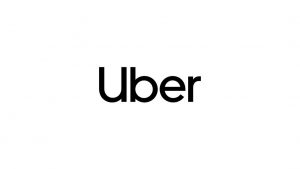
Although Uber is operating in the people moving industry, it is not a taxi company, but a ridesharing service.
The latest stats say there are 21 million trips a day taken by 111 million monthly active platform consumers located in over 900 cities across 69 countries. In 2019, the company registered $65 billion in gross bookings across all platforms.
How to create a blue ocean for your company through value innovation
Value innovation is one of Blue Ocean Strategy’s tools and is defined as the simultaneous pursuit of differentiation and low cost, creating a leap in value for both buyers and the company.

10 questions to increase employee retention
The concept of Value Innovation is the cornerstone of the market-creating strategy.
Because value to buyers comes from the offering’s utility minus its price, and because value to the company is generated from the offering’s price minus its cost, value innovation is achieved only when the whole system of utility, price, and cost is aligned.
Chan Kim and Renee Mauborgne
But how does one achieve value innovation?
To achieve value innovation, the company looks at two factors: cost savings and buyer value.
The company makes cost savings by eliminating and reducing the factors an industry competes on and lifts buyer value by raising and creating elements the industry has never offered.
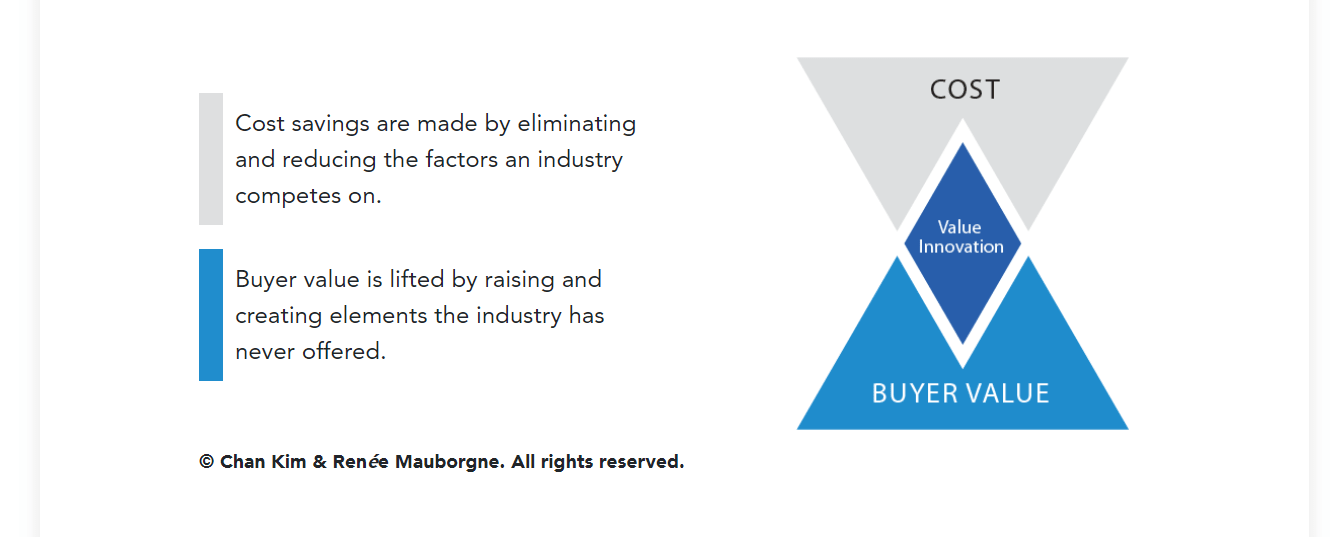
Many businesspeople believe that lowering costs and increasing value is a trade-off. It’s either creating greater value for customers at a higher cost or creating reasonable value at a lower cost. Blue Ocean Strategy allows companies to pursue differentiation and low cost simultaneously.
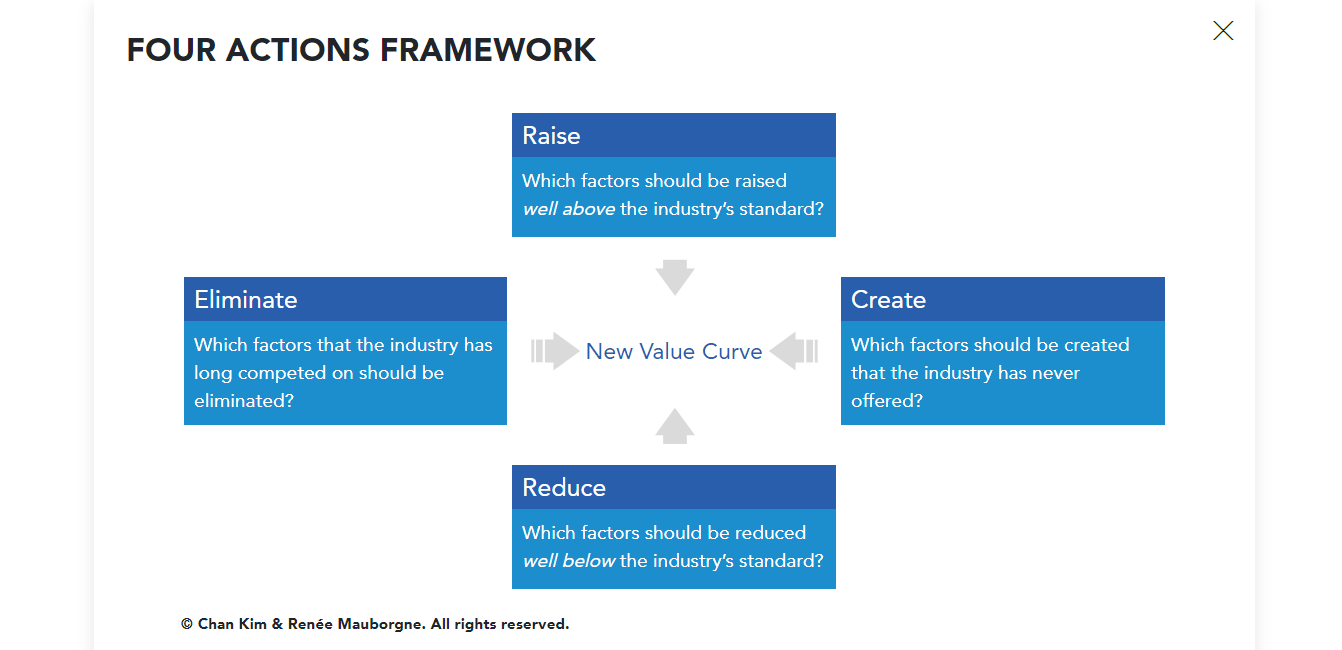
A great starting point for achieving value innovation is to answer the following questions devised by Chan Kim and Renee Mauborgne in the Four Actions Framework:
- Which of the factors that the industry takes for granted should be eliminated?
- Which factors should be reduced well below the industry’s standard?
- What factors should be raised well above the industry’s standard?
- What factors should be created that the industry has never offered?
In conclusion, to find your blue ocean, namely to tap into a new market, you need to perform an innovative leap in customer value at lower costs thus making the competition irrelevant.
Join the Conversation
We’d love to hear what you have to say.
Get in touch with us on our LinkedIn Group, Facebook Group or Twitter.
Is leadership reserved only for extroverts?
Do extroverts make the best leaders? Experienced leader and coach Stela Toderascu provides a surprising answer to this question.
Are you an extrovert or an introvert?
A month ago when I was doing some research on coaching introverted people, I came across this test. I was quite sure I am more extrovert than introvert so I was genuinely curious about the results of the test. I always thought of myself as an extrovert. I like to socialize, to have fun, to sing, at least I used to :). You would say these are prominent signs of an extrovert.
According to the result of the test, I am a public introvert and a private extrovert. After reading the description it made sense. I liked all the “extrovert” experiences but with people I knew well and felt comfortable with. I believe I am 50% introvert and 50% extrovert. I was told I am a good listener, a calm and peaceful person. At the same time I enjoy company, going out and speaking at conferences. I have led small teams and big teams, and working with proactive people always brought good results.
Forced extroversion is not healthy
A while back, in most of my one-to-one discussions with my supervisor regarding my development as a leader, he told me I needed to be visible, I needed to say something at every meeting, so people can see that I have opinions, that I am agile and involved.
I’ve done this several times and I was thinking it was helping me, but I wasn’t so happy about it, and I eventually understood why. What my supervisor had suggested me to do was forced, exercised, thought in advance, it was not spontaneous. I felt more comfortable managing projects and working in teams than being an “always present” member of the management team. I would present an idea only after being sure it’s a good one. I never thought this might be because I was an introvert.
Quiet people have the loudest minds.
Stephen Hawking
After taking the test and remembering my experience, one question popped in my head:
Are introverted leaders as good as the extrovert ones? What difference can they make in a company?
At least one thing is clear: based on my experience, the extroverts get noticed and get promoted faster :).
It’s simple really: they show confidence in themselves, they express their opinions with great ease and give the impression that they know what they are doing.
They have a quick answer to any question, they know good jokes and feel comfortable in any situation.
How not to notice such a person and why wouldn’t you want to have such leaders in your company?

Introverts bring different strengths to a management team
What about the introverts? They can bring different strengths to a management team: they are quieter, maybe too analytical, not so spontaneous.
At the same time, they are intuitive, good strategic thinkers, and good listeners.
They are not intruding, they can come up with a great idea if you let them analyze a bit and be sure it’s a good one.
Introverts are collaborative and work very well with both extroverts and other introverts, being open to suggestions and more effective in leading proactive teams.
[bctt tweet=”Stela Toderascu on achieving a balance between introverts and extroverts: I had the best results when I was part of a team comprised of 50% introverts and 50% extroverts.” username=”brand_minds”]
This 14 min Ted Talk by Angela Hucles made me even more confident that introverts can make good leaders.
There are no pure introverts or extroverts, but it’s estimated that 50% of the population are introverts.
Among the world’s business leaders 96% are extroverts
According to Harvard Business Review only 2% of people in senior leadership roles identify themselves as “introverts”. Extroversion is considered one of the most important traits a leader must have.
Having this in mind, I searched for introverted leaders and these are just a few names I could find: Bill Gates, Warren Buffett, Mark Zuckerberg, Albert Einstein, Larry Page, Al Gore, Marissa Mayer, JK Rowling, Mahatma Gandhi, Hillary Clinton, Michael Jordan, Elon Musk, Steve Wozniak and Barack Obama. Enough names to convince you?
In order to be open to creativity, one must have the capacity for constructive use of solitude. One must overcome the fear of being alone.
Rollo May, American existential psychologist and author of the influential book ‘Love and Will’
I think a good balance of extroverts and introverts in a management team is healthier than having extroverts only.

In my experience, I had the best results when I was part of a team comprised of 50% introverts and 50% extroverts.
Whether you manage a team of five people or you are the CEO of a 100 people company, consider achieving a healthy balance of introverts and extroverts in your team.
Give this idea a try and let me know how it went.
Join the Conversation
We’d love to hear what you have to say.
Get in touch with us on our LinkedIn Group, Facebook Group or Twitter.
How Coaching Your Team Makes You A Better Leader
Do you want to become a better leader? Read on to learn how coaching helped Stela Toderascu become a better leader for her team.
The Leader as a Coach
The day you become a manager, besides not having leadership training or a proper introduction to your new role, you also face a shock when you need to coordinate, inspire and develop a team of people who should completely trust you as their new leader.
It’s not a given that a brilliant specialist becomes a great leader. In the leadership position, it is more about the EQ than the IQ, and that makes a big difference.
Before you are a leader success is all about growing yourself. When you become a leader, success is all about growing others.
Jack Welch
Like many leaders, I had the opportunity to go through leadership training only several months after having been appointed department manager. You know that look in the eyes of your team when you get back from training and you start implementing the things you’ve just learnt. You can almost hear them say “ok, she went to another training and now she will try new things on us” 🙂

Leadership through coaching can be discouraging
Coaching-facilitated leadership can sometimes be discouraging. At the same time if you feel those new things can make positive changes, don’t hesitate to use what you’ve learnt.
[bctt tweet=”Stela Toderascu: Coaching brings out the best in people, saves time and drives long term results by creating a learning organization.” username=”brand_minds”]
In order to avoid awkwardness, just be sincere with your team and tell them what you are planning on doing with that info. Let them know how it will help each team member, and that you would be happy if they would be open to trying those new things, keeping the door open for any type of feedback. I really believe that being sincere is the most important thing when we talk about bringing the team on the same page.
The growth and development of people is the highest calling of leadership.
Harvey S. Firestone
A few months into my new managerial role, when I felt confident regarding my functional knowledge, the skill I was really proud of was that I could quickly find a solution for any type of problem. Also, when asking me for advice, each member of my team would get at least one solution in a very short period of time.
I was really proud of this skill until the moment I realized that what I was doing was totally wrong. Even if things moved faster and I felt empowered, it was not helping my team to think, develop and take the next step.
How coaching made me a better leader for my team
After new training, this time on how coaching can improve my leadership skills, I understood how important it was to involve team members in the solution-finding process and in reaching a final decision. It’s only in this case that they can learn, grow, feel engaged and accountable.
Of course, it was a big change for my team when instead of giving solutions I began asking them open questions. Nevertheless, progress became visible quite rapidly.
The biggest benefit for the team was the fact that they would develop new competencies all by themselves achieving autonomy and ownership in a short period of time.
Coaching brings out the best in people, saves time and drives long term results by creating a learning organization.
It was after implementing a coaching leadership style that I could easily identify my successors or the true talents that could become team leaders or get new roles in the company in a short period of time.

5 barriers to leadership through coaching
Leadership through coaching is not as easy as it sounds. I identified the following 5 barriers:
- When the relationship between manager and employee lacks trust;
- The personal style of the manager;
- When the employee doesn’t help the coaching process;
- The manager’s “ego”;
- Manager’s constant need for control.
In order to have a functional coaching relationship at work the manager should be a good active listener, should constantly give feedback, and ask open questions.
A manager with good coaching skills will always respect the differences between people and be confident in what he is doing by showing his confidence in coaching.
Another important factor of successful leadership through coaching is giving up full control and refraining from giving solutions even if they come to your mind every time an employee is telling you about an issue. In light of the above, some leaders also need coaching .
What is the recipe for coaching-facilitated leadership?
Set goals, promote discovery, perform active listening and encourage the employee to get to a minimum one solution and a plan to achieve that particular goal by asking open powerful questions.
Don’t forget to let people grow based on their own potential and don’t make them a copy of you.
Stela Toderascu
If you are curious about your leadership style you can take this 5-minute quiz.
Join the Conversation
We’d love to hear what you have to say.
Get in touch with us on Facebook Group and Twitter.
The Circle of Safety – Simon Sinek’s Rule For Great Leadership

Simon Sinek – Leaders Eat Last
I recently finished Simon Sinek’s book Leaders Eat Last. It took me one hour each day for seven days to read it; it took Simon twelve months to write it. In Acknowledgements, in the last chapter of his book, Simon mentions working fourteen hours a day for many days on end. He did extensive research on the subject, talked to many people, he flew to Afghanistan and interviewed commanders in the American Air Force and the American Navy, where great leadership makes the difference between life and death.
Learn more: Simon Sinek – 8 Things You Didn’t Know About Him
Simon is a cultural anthropologist by training and it shows extensively in his book. Cultural anthropology is in my top three most interesting topics so you can imagine my enthusiasm – I couldn’t put the book down. But don’t worry, there is no scientific jargon. Simon’s writing flows effortlessly and it is easy to understand. It’s a great book and if you haven’t read it yet, I highly recommend you do so as soon as possible.

image source: trulyhumanleadership.com
Leaders Eat Last is a book on leadership; what makes it stand out from other books on the same topic is the author’s approach.
Simon Sinek takes a fresh and original approach to leadership – he looks at leadership through the lens of cultural anthropology. What makes the book very interesting is that his observations are supported by real-life business case studies.
It’s not the purpose of this article to review the book but to introduce you to one of Simon Sinek’s concepts –
The Circle of Safety.
What is The Circle of Safety?
The goal of great leadership is to inspire employees to deliver their best work and support the organisation to become successful. Notice I didn’t use the verb manage because employees don’t expect to be managed – they expect to be inspired.

What are leaders required to do to achieve this goal?
All they need to do, according to Simon Sinek is implement The Circle of Safety in their organisation.
First, let’s establish what a successful organisation is. Here is Simon Sinek’s definition of the successful organisation:
A successful organisation overtakes its competitors through innovation, inspires respect both inside and outside, has the highest level of loyalty among its employees, the highest retention rate and has the ability to overcome any challenges that may arise.
Second, in regard to the concept of safety, Simon notes the following: safety goes both ways in that the leader ensures the safety of his employees and in turn, the employees ensure the safety of the organisation.
Having said that, let’s delve into The Circle of Safety concept and discover how it serves and supports great leadership.
Leaders have one job only: to create a company culture in which employees cooperate naturally towards growing the business. That’s the safety zone: when employees come to work not for the company, but for themselves and their colleagues.
Learn more: Keeping Your Employees Happy Is More Than A Higher Paycheck
Trust the leaders, trust the employees
How do leaders create this type of company culture? By earning their employees’ trust.
The trust between the organisation and its employees is essential. To earn their employees’ trust, leaders must first empower them.

When you work with people you trust they will do their job better in order to deserve and keep your trust. These employees will show loyalty and commitment to the organisation without the need for exterior incentives like promises, financial bonuses or other perks.
When people feel appreciated by the organisation, they feel safe and relaxed; this allows them to care about and connect with their colleagues and start working as a team to support the organisation achieve success and prosperity.
Protection from outside threats
Trust means employees feel protected from threats coming from inside the organisation.
When there are no layoff threats looming over them or workplace rivalries they must fight in order to survive, employees are more prepared to protect the company from outside threats. Internal rivalries lead to the weakening of the company, making it less capable of standing up to potential dangers.

People first, revenues second
Leaders must make employees their top priority, not company sales or revenues. No financial goal should take precedence over the people. In times of business crises, Simon supports the strategy of sacrificing financial vectors to save the employees- not the other way around.
Unlike the threats from outside the company which are not in our control, leaders can control the threats from inside the organisation.
They can take steps towards eliminating intimidation, humiliation, biased attitudes, isolation, feeling useless, feeling rejected and being stressed. Workplace stress and anxiety have very serious consequences on our health and well-being- there’s no doubt about it. Statistics report a direct link between a negative workplace and a wide range of illnesses: from physical and mental fatigue to obesity, heart disease, burnout and eventually death. Increasing levels of detachment among employees are also causing low retention and engagement rates.

Lynda Gratton will teach you how to keep your employees engaged and motivated to do great work. Get your tickets today!
No safety zone means a dangerous environment for the organisation
When the organisation doesn’t provide a safety zone for its people, various case studies of prominent companies showed that it gives rise to negative feelings like paranoia, cynicism and employees with personal agendas. In short: a dog-eat-dog kind of culture where arrogance, inflating egos and fear make the rules.
When employees are left to fend for themselves, they withhold valuable information regarding an imminent threat to the organisation. The relationships between employees and leaders are weak and everyone seeks to satisfy their own interests. That’s what happened to Nokia. Nokia’s culture of status, shared fear and temporal myopia contributed to its downfall.
Leaders can fight negativity by creating a powerful culture based on a transparent set of values and beliefs. In this culture, employees are given the power to make decisions on their own because their leaders have previously shown trust and empathy. Which means building the safety zone.

A safe environment breeds innovation
It’s the natural cooperation between employees that makes the company powerful and resilient, not their products or services.
When people believe that everyone else inside the company will take care of them, they will contribute to the free exchange of information and data.
Sharing knowledge and information is what great leadership is all about
In a safe organisation, the leader is willing to share knowledge and information just as much as the next employee. Actually, it’s the leader who sets the tone and takes the first step down the path of sharing valuable information.
Numerous case studies and research data report that a favourable working environment leads to organisational stability and long-term high-level performances.
We also maintain our loyalty towards the employer, we help each other and we take pride in our work doing our jobs with passion.

A leader’s role is to set the tone
A leader’s role is to be the first who throws himself in front of danger to protect the group.
When the safety zone is in place, this doesn’t happen because it doesn’t have to. The safety zone protects him and the organisation. His people protect the company from outside dangers so the situation in which he has to sacrifice himself doesn’t arise at all.
The true social benefit of trust is reciprocity. Trust feeds itself. The organisation supports the development and growth of its employees in order for them to take on more important responsibilities.

A leader’s job is to teach and mentor his employees into becoming more competent and to earn their trust.
If the organisation doesn’t trust its people, it will monitor and surveil them, it will time their bathroom breaks and phone conversations.
Leaders rely on employees to provide firsthand information and data and employees rely on their leaders to provide direction, guidance and safety.
Join BRAND MINDS 2023 and learn how to become a better leader from global business thinkers James Clear, Nassim Taleb, Lynda Gratton, Neil Patel, Renee Mauborgne, Blair Singer, Anne-Marie Imafidon and Duncan Wardle!
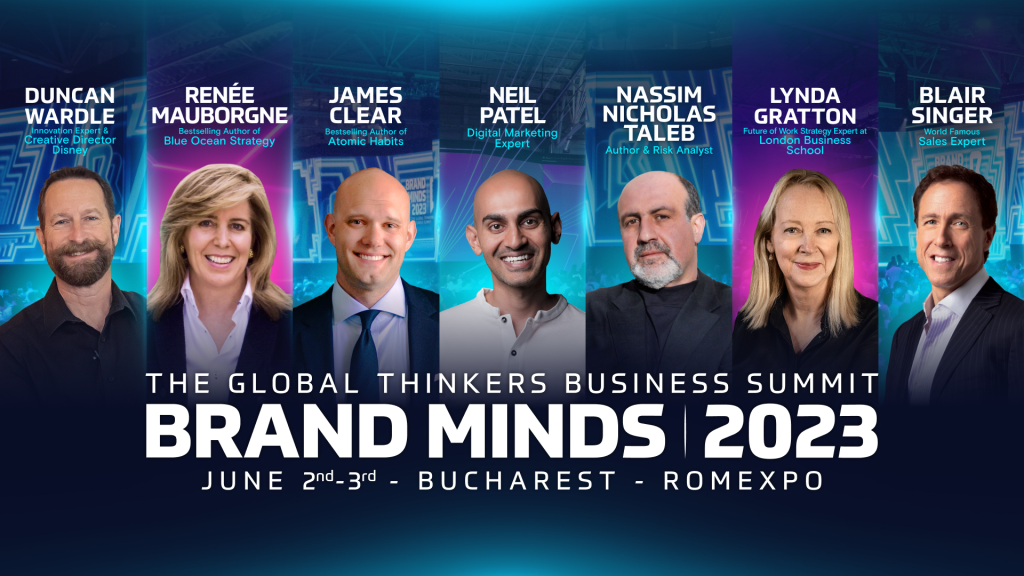
Diana Miron (JSLeague) – Changing The World One Block Of Code At A Time
Diana Miron is the CEO and co-founder of JSLeague.
A front-end developer and designer herself, Diana founded JSLeague as an intensive JavaScript school with headquarters in Romania, catering to the needs of the developers’ community in the Central Eastern European region.
With hard work and delivering real value, Diana and her team managed to build 6 communities, attracted 8 expert trainers to share their knowledge through workshops and put together 50 events to date. The JSLeague community includes over 3100 community developers.
Forbes 30 under 30 included Diana Miron, “a front-end developing guru” in its 2019 European list for Technology.
Excited and proud to learn of her accomplishment, I reached out to Diana looking to know more about her and JSLeague.

Diana Miron, CEO & co-founder JSLeague
1. What is the story behind JSLeague? How did it all start?
The story starts back 3 years ago within the Bucharest JavaScript community, the biggest community of JavaScript developers in Romania. Every month we organize meetups where members are able to present new ideas and interesting projects on different technologies.
JSgirls developed as a spin-off community for girls, having delivered JavaScript workshops in high schools in collaboration with Codette, an NGO that empower women to take a career in programming.
JSHacks, the first JavaScript-based hackathon came afterwards as a way to help programmers develop solutions to real-life problems while tackling challenges such as Open Data or technologies such as Blockchain and Machine Learning.
JSLeague started from this community with the focus on providing higher education to developers and taking them from good to great, inspiring them to be leaders within their teams and unite them into developing solutions for real problems.
We want to give developers from our community free access to the best tech trainers and the newest JS curricula throughout our JS workshops. We cover all JS tech stack and beyond, focusing on both the technical and soft skills by integrating Agile and Scrum methodologies with the help of our partners, Dovelopers.
JSLeague is the first organization to have built such an ecosystem around web technologies in Romania.

BucharestJS Meetup (image source: Facebook)
2. Your goal is to have a positive impact on the JavaScript community in the CEE region. Tell us three challenges you were faced with while working to achieve this goal.
We deeply believe that both people and companies should invest more in education at all levels. This investment requires time and effort from both parties and is developed throughout a large period of time and cannot happen overnight no matter how fast we would like it to be. We believe that this is the biggest challenge both ourselves and the environment are facing at the moment.
Building a community of united developers requires a spirit of collaboration and knowledge sharing from all entities involved, this being a JSLeague core value.
Unfortunately, there are people that don’t share the same values with us and this is a challenge in doing great work together. We believe that as a community we can achieve and contribute more to the world than individuals.
Lastly, another challenge we faced is the communication between companies and developers. We think that this communication should be more personal and authentic. We want to help both sides understand each other, their requirements, desires and needs in order to develop great products thus bridging the gap between them.
[bctt tweet=”Diana Miron@JSLeague: We believe that as a community we can achieve and contribute more to the world than individuals.” username=”brand_minds”]
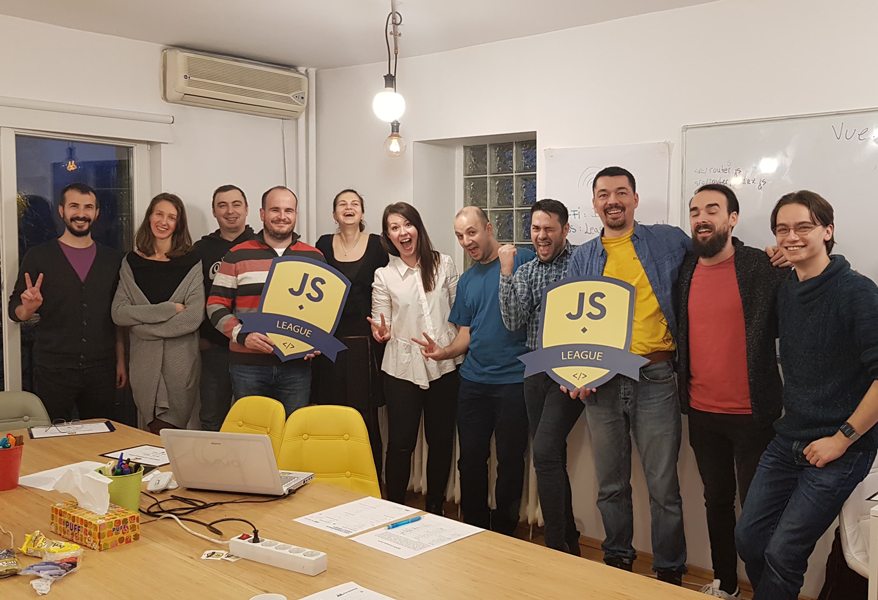
Diana Miron and the JSLeague team / jsleague.ro
3. What are the core values of your leadership and how is your leadership changing the world?
With education, passion for programming and giving back as our core values, we encourage developers to be open source contributors, to build better software products and to share expertise across tech communities by giving access to tech influencers, leaders or investors.
We highly believe in giving back to the community and giving access to free tech education, starting with kids to high school students to experienced developers. This is the reason most of our efforts are put into hands-on JS workshops and into community events.
JSLeague is a space where developers can play with new technologies, build products and share their knowledge.
Each one of us, members of the community can put their unique skills to contribute both locally and globally to projects thus changing the world one block of code at a time.
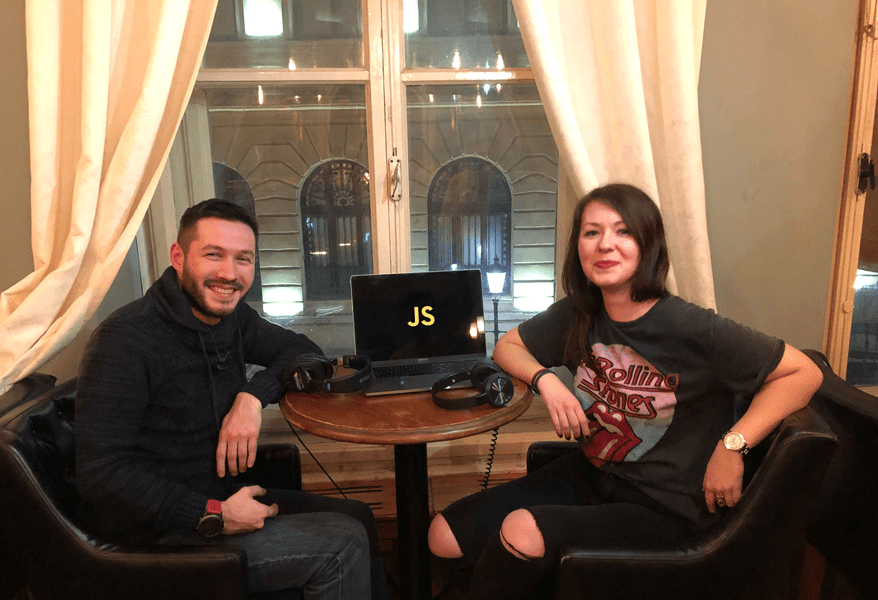
JSLeague Podcast: Diana Miron and Mihail Serafim before going live
Join the Conversation
We’d love to hear what you have to say.
Get in touch with us on Facebook Group and Twitter.
Mădălin Preda (Deqod) – On Leadership and Technology
Mădălin Preda is CMO and co-founder of Deqod. Deqod is a custom software and digital innovation company that empowers thought leaders, growing companies and visionary startups to unlock their company valuation and greater profitability through strategic technology development.
The company is specialized in developing solutions for mobile and e-commerce, leveraging latest technology like AR/VR, Artificial Intelligence, bots, IoT (internet of things) and Blockchain.
The team behind Deqod has gained vast experience in the e-commerce solutions field with over 1,000 merchants using their apps for their businesses.
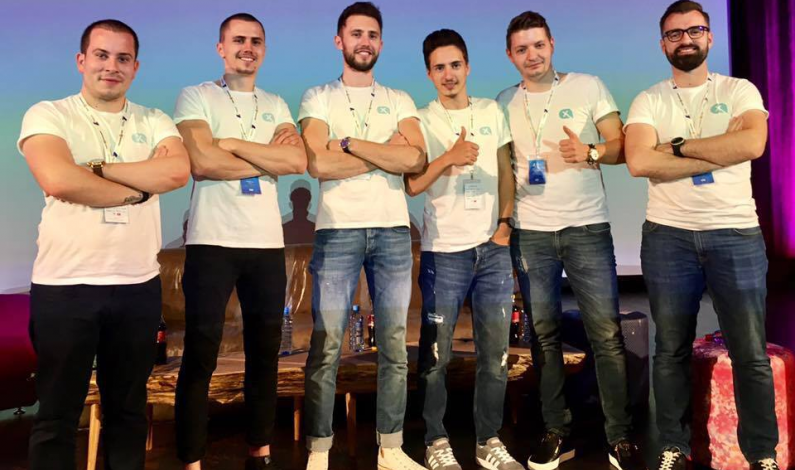
Echipa ChatX / startupcafe.ro
ChatX Search is one of the solutions crafted by Deqod; the bot helps retail businesses boost online store sales with the same traffic.
Learn more: How To Use Chatbots To Increase Sales
I was interested to learn Mădălin Preda’s perspective on technology and leadership so I asked him the following questions:
1. What is the relationship between technology & leadership? Does leadership drive technology?
Technology has a very big impact on our lives nowadays, there is no question about it. We are humans. We invented and developed technologies to improve our lives as much as we can.
Technology has changed our day to day routine so much by automating part of some processes and giving us extra time to spend it on different priorities. But not just that, also the way we do things.
We connect more and more with people online and less face to face. The way we do business changes since we’re starting to have more and more AI that is taking over implementation processes that used to be done by people.
At a high management level, technology can be one of the most useful tools to help us become better leaders.
Leadership nowadays has so many ways to reach people’s needs that it didn’t have before. Communication channels improved exponentially in the past years giving us the possibility to reach and influence people on a deeper level.
Your message as a leading brand in your industry has a bigger potential to be heard and understood by your audience nowadays through technology. The ways you motivate sales teams, build customer loyalty and connect with peers through various social media platforms and blogging changed as well.
There is no question about the fact that technology is the main support that helps in spreading the word like never before.
2. Henry Ford is known to have said, “If I had asked people what they wanted, they would have said faster horses.” What challenges did you encounter while working with your customers to deliver them technological solutions?
Customers sometimes can’t find the perfect way to explain to us their real problems. Some of them may not even know what they need (from a technical perspective). However, what they can tell us in customer jargon, is how they feel when using a product, its colours, design and what they can or can’t use.
The biggest challenge is to fulfil their expectations that constantly keep on changing, by keeping ourselves one step ahead.
You should begin building a foundation that helps you understand your customers, in order to create a bridge between your brand and your audience. Ask questions around their problems and then bridge the gap with your innovation.
Finally, it’s about establishing the customer satisfaction gap by comparing the customer expectations about the product with the actual product performance.
Call it psychology or not, but after you understand their perspectives, you can validate these findings with intuitive modes and methods.
3. What are the core values of your leadership?
From my perspective, I truly believe the easiest part of leadership is deliberating business decisions or making your voice be heard.
Then comes the hard part, being sure everyone on your team knows and feels how appreciated they are.
Our job isn’t to lead the team, but rather to support them.
[bctt tweet=”Madalin Preda@Deqod on leading teams: Our job isn’t to lead the team, but rather to support them.” username=”brand_minds”]
By giving someone a push to become more visible and showing interest in their inputs, you are making them know that they really matter.
Without open and transparent communication, there is little room for innovation, collaboration, and engagement with your employees.
Leaders need to start treating employees as humans, not numbers.
Read our previous Success Stories:
Alex Govoreanu-Exploring Games with Questo,
Mihai Toader-Pasti: Building The Homes of The Future at EFdeN.
Join the Conversation
We’d love to hear what you have to say.
Get in touch with us on Facebook Group and Twitter.
Mihai-Toader Pasti: Building The Homes of the Future at EFdeN

Mihai Toader Pasti is building the homes of the future as co-founder and General Manager of EFdeN & energiaTa.
EFdeN is an NGO founded in 2012 by a group of passionate young people committed to making Romania more sustainable.
Read the previous success story: Alex Govoreanu – Exploring Games with Questo.
Together with a team of seventy people with various education backgrounds (urbanism, design, architecture, 5 types of engineering, horticulture, communication and management), Mihai has been designing and building greenhouses for the past nine years.
Since 2010, he participated in 3 editions of Solar Decathlon, the world’s most important competition for sustainable homes. At each edition, the greenhouse designed and built by the EFdeN team won prestigious awards, bringing the total number of awards to 35.
How does Mihai envision the house of the future?
He says the house of the future will become more interactive. The house will interact differently depending on the age or health issues of its owner. Maybe it will soothe a crying baby or cater to the needs of a sick old man. People suffering from depression or anxiety spend a lot of time indoors. Mihai is asking himself how their home could help them manage their illnesses.

Mihai-Toader Pasti / linkedin.com
I was interested to know more about EFdeN so I asked Mihai-Toader Pasti the following questions:
1. What is the story behind EFdeN? How did it all start?
The story of EFdeN starts two years before it was founded, in 2010, when two relevant things happened.
A young architect called Pierre Bortnowski visiting Madrid was hanging out with his friends in Casa de Campo Park. In the same time, the finals of the world’s most important competition for solar homes were taking place. As a young assistant to the University of Architecture, at his return in Romania, he had a dream: for Romania to participate in this competition.
So he started gathering people to make it happen and this is how PRISPA project started in 2010. I was part, along with other colleagues who later joined EFdeN, of the PRISPA project. Unfortunately, the PRISPA house had to be sold in order to cover the participation expenses, so after the competition, the team dissolved, and the project didn’t go any further.
But some of us really wanted to go further. This is why EFdeN was born in 2012. In a studio in Bucharest and not in a garage as other successful stories, because we did not even have a house. We had just one simple idea and one mission: to offer to other people at least the same experience we had in PRISPA, to create an educational context and opportunities.
We wanted to create a sustainable organisation that could offer meaningful and practical experience for young architects, engineers and designers, to raise awareness of climate change problems and try to mitigate them on a country level.
We did not aim for awards, fame or money, we just wanted this dream to live for decades, to not die. The fact we managed to do so many projects, while also changing a law in Romania and creating with energiaTa the biggest community of energy prosumers is something that happened because we always tried to push the boundaries of what is possible here.
2. In 2013, your team has grown from five to seventy people. What is your role as a leader?
My role as a leader was to get everything done in time and within the budget, while convincing enough people to pursue together and long enough a crazy shared dream: to be the best we could, to create the best home we could for Solar Decathlon competition.
People usually underestimate how challenging such a project can be. We have 2 years to create everything from scratch; we are responsible from concept and design to actually build a house with our own hands, a house which has to function in the best competition in the world for solar homes, after transporting it for more than 4700 km and assembling it in just 15 days.
We are also responsible for fundraising all the money, products and services we need. There is an enormous amount of things that could go wrong and we are responsible to solve them all, no big brother or sister to call, no parent to do our homework.
3. In the last four years, EFdeN has benefited from the active support of over 500 volunteers and supporters. How did you and your team manage to get everyone on the same page? What challenges did you encounter?
EFdeN is a truly amazing experience for everyone, from new members to coordinators and the management team. In time we had some amazing challenges to overcome: Theory to Practice, Financing & Partnerships, Teamwork & Interdisciplinarity, Long term planning and Execution.
We are constantly around 35 people and the average age in our project in 22 years old, the youngest is 19, the oldest is 31, having 50% gender balance.
Almost no-one has any working experience when they join our team and the vast majority never built anything in their life or had any experience in teamwork.
So in 2 years, until our first EFdeN participation in Solar Decathlon, we had to go from zero to hero which we successfully did.
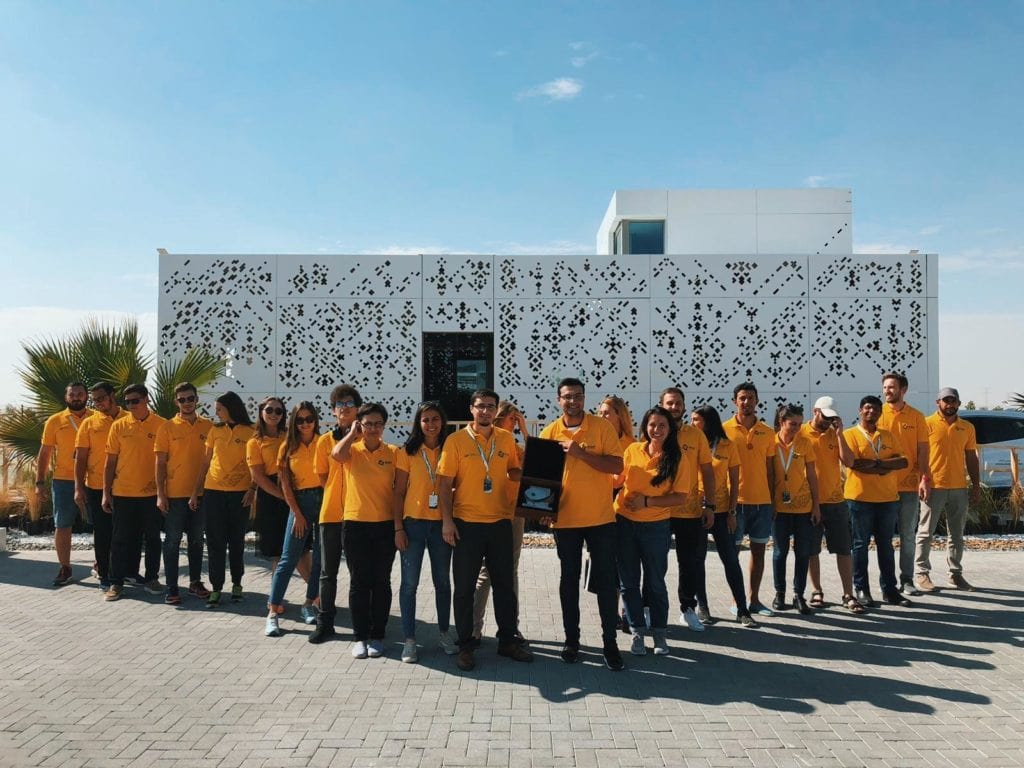
Team EFdeN at the 2018 Solar Decathlon, Dubai / business-review.eu
In time we got better and better. For example, at the most recent Solar Decathlon competition we participated in (which took place in Dubai), we were on the podium 4 times in Engineering and Construction, Comfort Conditions, Sustainability and Communication.
How did we do that? By keeping our eyes on the ball, by doing lots of sacrifices, by loving what we do and by finding beacons of hope and energy in our own team and in society.
But the truth is you cannot get everyone on the same page. There are always people who don’t trust us or who are not ready for the sacrifice it takes. It happened the same to us, it was not all the land of milk and honey, but we found common ground.
There were many people who didn’t trust us and who refused to support us along our journey. But there were also some who supported us, and this made all the difference.
We are very thankful to our more than 120 sponsors that chose to support us and also to all the volunteers who were ever part of EFdeN and believed in this dream and put their time and energy into it.

Signature – EFdeN’s greenhouse at the 2018 Solar Decathlon / economica.net
Join the Conversation
We’d love to hear what you have to say.
Get in touch with us on Facebook Group and Twitter.
Simon Sinek: 8 Things You Didn’t Know About Him
I was curious to learn more about Simon Sinek, about his own personal journey to the man we see today on stage and in YouTube videos.
This article is about sharing with you 8 things I discovered I didn’t know about Simon Sinek.

Simon Sinek/facebook.com
Simon Sinek is a leadership speaker, a professor at Columbia University, a trained ethnographer and author of five books on the power of leadership:
Start with Why (2009),
Leaders Eat Last (2014),
Together is Better (2016),
Find Your Why (2017)
and
The Infinite Game (2018).
He flies around the world to speak at large conventions and conferences teaching leaders to improve themselves and the lives of their employees.
I was curious to learn more about Simon Sinek, about his own personal journey to the man we see today on stage and in YouTube videos.
Here are 8 things you didn’t know about Simon Sinek:
1. He was an intrapreneur in the corporate world
After graduating in cultural anthropology, Simon Sinek enrolled in law school. He quickly realized it wasn’t for him, so he dropped out of law school and entered the corporate world by taking jobs in advertising and marketing agencies.
As a marketer, he was constantly looking for a better way to do things. He heard a lot of That’s not how we do things around here, although his creativity allowed him to find new ways to accomplish tasks and deliver projects. After a few years, in 2002 he quit his ad business and started his own marketing firm.
2. He saw the pattern
Throughout his marketing career, he was fascinated by why some companies succeeded and others didn’t.
He looked at the great marketers who everyone admired and recognized that there was a pattern in which they spoke to the audience. They communicated marketing campaigns in the same way, they organized information the same.
That’s when he wrote down his observations and came up with his idea – The Golden Circle.
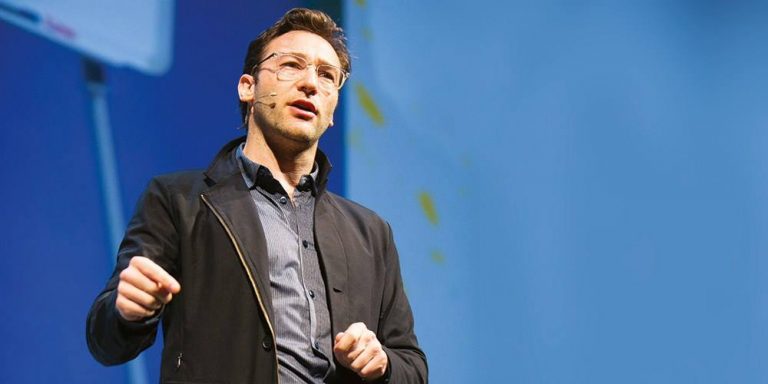
image source: facebook.com
3. He gave his first talk in a friend’s living room
The year was 2006. He started talking about his discovery in his friends’ living rooms.
What he discovered changed his life profoundly. He talked obsessively about it to his friends and anyone willing to listen.
His friends began spreading his idea to their friends, so Simon’s ideas began reaching a wider circle of people through word-of-mouth.
4. Teach Me!
Entrepreneurs and small-business owners began asking him to teach them how to discover their Why. In parallel with working at his own marketing firm, Simon began earning money on the side for teaching others how to improve their marketing campaigns and get their message across more efficiently.
5. Testing, testing…
Soon he discovered he only wanted to spread the message of the Why.
He didn’t yet know what form his endeavour would take, but he knew he had to do it. Like any scientist, he decided to test his theory. In order to do that, he needed to begin with a clean slate, so he closed his marketing firm.
He needed to prove his theory, so he started from scratch. He began looking at all the different places he could try to test his theory: small and big businesses, businesses in different industries, public and private companies, government, military, politics etc. He kept applying his theory to various organizations expecting it to fail. Only it didn’t.
6. His 2009 TEDx Talk: He didn’t seek it out
He didn’t seek out the opportunity to give a TED Talk. His message about The Golden Circle and the Why spread organically. He was approached by someone at TED and invited to give a talk on his theory. He was ready. He had been giving his speech for the past three years so the only challenge he faced at that moment was delivering it in twenty minutes instead of an hour, the normal length. He gave the best talk he could, and it made history.
To date, his speech has a viewership of 42 million views.
7. He never set out to become a public speaker
He didn’t set himself on the course to be a public speaker, it’s not a chosen profession. He does it because he believes in the message and he thinks it’s important to go and preach that message. It’s an amazing experience and he feels humbled by the large scale his message has taken.
8. Simon Sinek’s learned lesson
What do entrepreneurs do that Simon Sinek considers stupid?
It’s something he felt himself in his entrepreneurial days. He thought he had to know all the answers and if he didn’t, he thought he had to pretend that he did. Which Simon Sinek thinks it’s stupid.
The biggest lesson Simon Sinek learned in his days of being a business owner was to learn to say I don’t know, I don’t understand, or I need help.
Join the Conversation
We’d love to hear what you have to say.
Get in touch with us on Facebook Group and Twitter.
